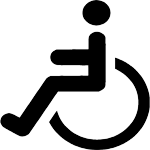Accurate and dependable data is essential for planning, framing policies and developing programmes in order to address any issue in a focused manner. It is true of the data on persons with disabilities. The statistical information should not only be accurate, it should also be available within a reasonably acceptable time frame before it becomes obsolete. It is also necessary that the data cover wide range of information, such as type of disability, age profile, rural and urban distribution, education, employment status, etc for effective intervention and desired outcomes.
Collection of data on disability dates back to 1872 with the first Indian Census. Until 1931, it was referred to as infirmity. The National Sample Survey Organisation (NSSO) made the first attempt to collect data on the number of persons with disabilities in the 15th round during July, 1959 to June, 1960. However, those data did not contain the required details, nor was it a regular feature.
The infirmity rate per 1 lakh population varied between 228 to 369 during 1881 and 1931 i.e. approx 0.23 percent to 0.37* percent of the population. The infirmities included insanity, deaf-muteness, blindness and leprosy.
Registrar General and Census Commissioner of India (RG & CCI) included the question on disability status in Census 2001 & 2011. Summary of the findings of Census 2011 is as under:-
- In India out of the 121 Cr population, 2.68 Cr persons are ‘disabled’ which is 2.21% of the total population.
|
Population, India 2011 |
Disabled persons, India 2011 |
||||
|
Persons |
Males |
Females |
Persons |
Males |
Females |
|
121.08 Cr |
62.32 Cr |
58.76Cr |
2.68 Cr |
1.5 Cr |
1.18 Cr |
- Among the disabled population 56% (1.5 Cr) are males and 44% (1.18 Cr ) are females. In the total population, the male and female population are 51% and 49% respectively.
- Majority (69%) of the disabled population resided in rural areas (1.86 Cr disabled persons in rural areas and 0.81 Cr in urban areas). In the case of total population also, 69% are from rural areas while the remaining 31% resided in urban areas.
- The percentage of disabled population among males and females are 2.41% and 2.01% respectively. At all India level as well as disaggregated by various social groups, the proportion of disabled in the corresponding population is higher for males than females.
- During 2001 – 2011, an increase in the number of disabled persons was observed both in rural and urban areas and also among males and females. The share of disabled persons in the total population, as well as in the male and female population also increased during this period.
- The percentage of disabled to the total population increased from 2.13% in 2001 to 2.21% in 2011. In rural areas, the increase was from 2.21% in 2001 to 2.24% in 2011 whereas, in urban areas, it increased from 1.93% to 2.17% during this period. The same trend was observed among males and females during this period.
- The percentage decadal change in disabled population during 2001 -2011 is 22.4, whereas for the total population, the percentage decadal change is 17.7.
- In India, 20% of the disabled persons are having disability in movement, 19% are with disability in seeing, and another 19 % are with disability in hearing. 8% has multiple disabilities.
- Males are more in number among the affected for all the types of disability.
- Among the male disabled, 22% are having disability in movement, 18% each has disability in seeing/ in hearing while 8% of them suffered from multiple disability. In the case of the female disabled, 20% each has disability in seeing / in hearing, 18% has disability in movement and 8% of them are having multiple disability.
- The number of disabled persons is highest in the age group 10-19 years (46.2 lakhs).
- 17% of the disabled population is in the age group 10-19 years and 16% of them are in the age group 20-29 years.
- Elderly (60+ years) disabled constituted 21% of the total disabled at all India level.
- The percentage of disabled is highest in the age group 10-19 years followed by age group 20-29 years for both the male and female disabled persons.
- Among the disabled males, 18% are elderly (above 60 years of age) whereas 23% of female disabled are elderly.
- Out of the total disabled in the age group 0-19 years, 20% are having disability in hearing followed by 18% with disability in seeing. 9% has multiple disabilities.
- Among the disabled in the age group 20-39 years, 22% are having disability in movement and 18% has disability in hearing. 6% has multiple disabilities.
- Among the disabled in the age group 40-59 years, 23% are having disability in movement and 19% has disability in seeing. 5% has multiple disabilities.
- Among the elderly disabled persons, the disabilities in movement (25%), in seeing (25%) and hearing (12%) are prominent. 12% has multiple disabilities.
- 1.24% of the total children (0-6 years) are disabled. The percentage of male disabled children to total male children is 1.29% and the corresponding figure for females is 1.19%.
- The proportion of disabled males to total males is higher than the corresponding proportion for females at all India and at rural and urban areas. The same pattern has been observed in the case of children (0-6) years.
- The proportion of disabled to the total population for all ages is higher in rural areas for both males and females, while for children, the same is higher in urban areas.
- 23% of the disabled children (0-6 years) are having disability in hearing, 30% in seeing and 10% in movement. 7% of the disabled children have multiple disabilities. A similar pattern is observed among male and female disabled children.
- 61% of the disabled children aged 5-19 years are attending educational institution.
- Among the disabled children aged 5-19 years who were attending educational institutions, 57% are male children.
- The rate of school attendance of disabled children (5-19 years) is higher in urban areas (65%) compared to rural areas (60%).
- Among all the female disabled children (5-19 years), 60% are attending institutions, while among the male disabled children the 62% are attending educational institutions.
- 54% of the disabled children with multiple disabilities never attended educational institutions. Also, 50% of the children with mental illness never attended educational institution.
- The Census 2011 showed that, 8.3% (207.8 lakhs) of the total households in the Country are having disabled persons of which 71% are in rural areas. Out of the total households1 with disabled persons, about 99.34% households are normal households, 0.42% is institutional and 0.24% is houseless households.
- Of the total disabled population, nearly 55% (1.46 Cr.) are literates.
- Out of the male disabled population, 62% are literates and among the female disabled 45% are literates.
- In the rural areas, 49% of the disabled are literates while in urban areas, the percentage of literates among disabled population is 67%.
- Among the total disabled persons, 45% are illiterates. 13% of the disabled population has matric/ secondary education but are not graduates and 5% are graduates and above. Nearly 8.5% among the disabled literates are graduates.
- Among the male disabled persons, 38% are illiterates. 16% of the disabled male population has matric/ secondary education but are not graduates and 6% are graduates and above. About 9% among the male disabled literates are graduates.
- Among the female disabled persons, 55% are illiterates. 9% of the disabled female population has matric/ secondary education but are not graduates and 3% are graduates and above. About 7.7% among the female disabled literates, are graduates.
- Illiteracy was high among female disabled in rural areas.
|
Comparison of Literacy status of disabled persons by Sex and Residence in India – Census, 2011 |
||||
|
|
Literate |
Illiterate |
||
|
Rural |
Urban |
Rural |
Urban |
|
|
Person |
49 |
67 |
51 |
33 |
|
Male |
58 |
72 |
42 |
28 |
|
Female |
37 |
61 |
63 |
39 |
- The educational level of disabled persons is better in urban areas compared to rural areas, both for males and females.
- In urban areas, 67% of the total disabled persons are literate vis –a –vis 49% in rural areas. In urban areas 20% has matric/ secondary level education but below graduate and 10% are graduate and above, while in rural areas, the corresponding figures are 10% and 2% respectively.
- In urban areas, among the disabled who are literates, 15% of them are graduates, while in rural areas only 5% of them are graduates.
- At all India level, 36% of the total disabled persons are workers. Among the male disabled persons, 47% are working and among female disabled, only 23% are working.
- In rural India, 25% of the female disabled are working, while in urban India, the corresponding figure is 16%.
- Among the disabled persons who were workers, 31% were agricultural labourers.
|
Distribution of Disabled Workers in India – Census, 2011 |
||||
|
Total |
Cultivators (CL) |
Agriculture Labourers |
In Household Industries (HHI) |
Others |
|
97,44,386 |
22,74,322 |
29,77,272 |
4,35,053 |
40,57,739 |
|
% |
23 |
31 |
4 |
42 |
- One in every 25 disabled children in the age group 0-14 years is working, while 50% of the disabled population in the age group 15 -59 years is working.
|
Proportion of Workers, Main workers and Marginal workers by respective age group to total disabled in India – Census, 2011 |
|||
|
Disabled |
Workers (WPR) |
Main Workers |
Marginal Workers |
|
Total |
36.3 |
26.0 |
10.3 |
|
0-14 |
4.1 |
1.8 |
2.3 |
|
15-59 |
50.5 |
36.9 |
13.6 |
|
60+ |
28.3 |
19.3 |
9.0 |
|
Age not stated |
37.5 |
26.2 |
11.3 |
|
WPR – Worker Population Ratio |
|||
- As per Census 2011, there are 1.7 Cr. disabled non –workers, among them 46% were males and 54% females.
- Among the total disabled non –workers, about 46% are in the age group 15 -59 years, 31% in the age group 0-14 years and 23% are 60+ years. Among the male disabled non – workers, 42% belonged to the age group 15-59 years, while 49% of the female disabled non-workers belonged to this age group. While the share of disabled non –workers are higher in 0-14 age group compared to 60+ years age group, for both male and female disabled non –workers, for females the difference is less.
- One in every two disabled non-workers is dependent on their respective families. Among the male disabled non –workers, nearly 33% are students, while the same among the corresponding category of females is 22%.
- Among the disabled non –workers, for all type of disability, percent of dependents are highest followed by students and those performing household duties except for mental illness, where percent of disabled engaged in household duties is more than that of students.
- Among the disabled non –workers with disability in seeing, 42.7% are dependents and 28% are students; among those with disability in hearing 38.7% are dependents and 32.5% are students.
- In the case of disabled non –workers, with disability in speech, 33.5% are dependents while 37.2% are students, while among those with disability in movement 49.8% are dependents and 19.7% are students.
- Among disabled non-workers with mental retardation, 57.7% are dependents and 24.5% are students while those among the disabled with mental illness 66.6% are dependents and 9.3% are students. For persons with multiple disabilities in this category, 65.9% are dependents and 15% are students.
|
Disabled non – workers by type of disability and by major non-economic activity in India-Census, 2011 |
||||||||
|
Type of Disability |
Total (Millions) |
Major Non-Economic Activity (%) |
||||||
|
Student |
Household duties |
Dependent |
Pensioner |
Rentier |
Beggar, Vagrants, etc. |
Others |
||
|
Total disabled non-worker |
17.1 |
27.2 |
15.3 |
45.7 |
5.5 |
0.2 |
0.4 |
5.6 |
|
In seeing |
3.1 |
28.0 |
17.3 |
42.7 |
6.7 |
0.2 |
0.4 |
4.7 |
|
In Hearing |
3.0 |
32.5 |
18.9 |
38.7 |
4.9 |
0.2 |
0.2 |
4.6 |
|
In Speech |
1.2 |
37.2 |
20.0 |
33.5 |
3.4 |
0.2 |
0.2 |
5.4 |
|
In Movement |
3.4 |
19.7 |
13.4 |
49.8 |
8.8 |
0.3 |
0.6 |
7.4 |
|
Metal Retardation |
1.2 |
24.5 |
9.6 |
57.7 |
2.1 |
0.2 |
0.5 |
5.4 |
|
Mental Illness |
0.6 |
9.3 |
11.9 |
66.6 |
2.8 |
0.2 |
1.0 |
8.2 |
|
Any other |
2.9 |
37.4 |
17.7 |
35.4 |
3.2 |
0.2 |
0.3 |
5.8 |
|
Multiple Disability |
1.7 |
15.0 |
7.3 |
65.9 |
6.8 |
0.2 |
0.6 |
4.3 |
- 46.87% of the total disabled persons are currently married, whereas 41.72% are never married and 10.29% of them are widowed.
- Among the total disabled persons in the age group 15+ years, 59% are currently married and 13% are widowed. Among the male disabled, 62% are currently married and 6% are widowed while for female disabled, the corresponding figures are 54% and 13% respectively.














